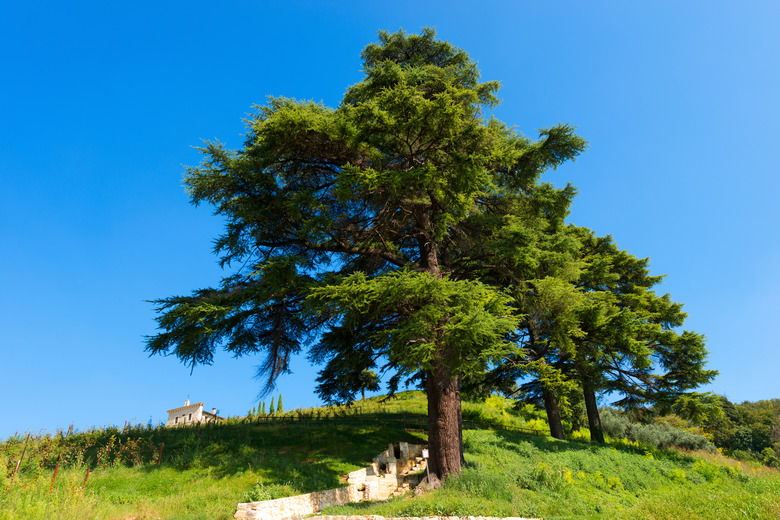The Best Time To Transplant Cedar Trees
We may receive a commission on purchases made from links.
True cedars (Cedrus spp.) are native to the western Himalayas and the Mediterranean region. When adding a new tree to your landscape, the best time to transplant cedar trees is in fall, late winter and early spring when many trees are still dormant. Hardy in U.S. Department of Agriculture plant hardiness zones 5 through 10 depending on the species, there are two primary "true" cedars. Carefully consider where to plant a cedar because they grow into large trees and can overwhelm a small landscape.
True Cedars and More
True Cedars and More
The true cedar species are the deodar cedar (Cedrus deodara, zones 7-8), which is also known as the Himalayan cedar, and the Lebanon cedar (Cedrus libani, zones 6-7). Two subspecies of the Lebanon cedar are the atlas cedar (Cedrus libani subsp. atlantica) and Cyprus cedar (Cedrus libani subsp. brevifolia). Under ideal conditions in their native habitats, the true cedars grow to 100 feet or more.
In the average North American landscape, while still very tall trees, cedars tend to grow 40 to 60 feet tall. There are smaller cultivars available, including the weeping blue atlas cedar (Cedrus libani subsp. atlantica 'Glauca Pendula,' zones 6-7), which only grows about 10 feet tall when staked and trained upward, making it an attractive focal point in a small landscape.
There are a number of North American native trees also known as "cedars," which are actually members of the juniper and cypress families (Cupressaceae). Familiar names among the other cedars are the Eastern red cedar (Juniperus virginiana), which is a perennial in USDA zones 2 through 9, and the Western red cedar (Thuja plicata), hardy in USDA zones 5 through 7.
Identifying a True Cedar
Identifying a True Cedar
A quick way to determine whether the potted cedar tree in the garden center is a true cedar or other cedar species is to look at the needles. The true cedars produce 3/4- to 2-inch-long stiff needles that grow in spiral clusters, or rosettes. The other cedars have shorter, prickly needles when young, which become softer, thicker and flattened and have a scalelike appearance as the trees mature. In addition, true cedars produce barrel-shaped cones that grow upward from the branches.
Best Time to Transplant Cedars
Best Time to Transplant Cedars
Cedar trees, like other tree species, are best transplanted in early fall, late winter or early spring. While potted trees can technically be planted at any time of the year, planting during the hottest part of summer requires careful monitoring of the soil using a soil moisture meter so the tree doesn't wilt and die. Young cedar trees prefer an evenly moist soil, though mature trees can tolerate some drought.
Select a sunny, well-draining location in the garden where the cedar tree will have room to grow. Avoid planting near power lines, hardscapes or buildings; while the true cedars grow at a slow to moderate rate, they mature into very large trees. Cedars prefer acidic, loamy soils, though they tolerate sandy and clay soils. Dig a planting hole as deep as the root ball and two to three times as wide. Chop into the sides and bottom of the hole with a shovel to loosen the surrounding soil.
Settle the tree into the center of the hole at the same level as it was previously planted and backfill with the excavated soil. Tamp gently and water thoroughly. Cover the bare soil around the tree with 2 to 4 inches of organic mulch, pulling it back 6 inches from the trunk. Water the newly planted tree weekly when the soil is dry to a depth of 2 to 4 inches. Wait until early spring to fertilize and then apply a 10-10-10 slow-release fertilizer with micronutrients.
References
- Oregon State University: True Cedars (Cedrus)
- North Carolina Extension Gardener Plant Toolbox: Cedrus atlantica
- Missouri Botanical Garden: Cedrus deodara
- Urban Forest Ecosystems Institute: Cedar of Lebanon
- University of Arizona Cooperative Extension, Yavapai County: Backyard Gardener – The Cedars of Lebanon and Beyond
- North Carolina Extension Gardener Plant Toolbox: Juniperus virginiana
- North Carolina Extension Gardener Plant Toolbox: Thuja plicata
- University of Tennessee Agricultural Extension Service: Transplanting Trees
